|
ON:
Dr. Jean Koenig, how long have you been studying orchids?
JK: I have been studying orchids since
more than 50 years. I have got the virus very early. My parents
were interested in orchids and I used to observe some sites with
them as I was a young boy.
ON: How many orchids genera and species occur in France?
JK: We have 27 genera and more than 160
taxas. In my opinion, not all are full species.
ON: In your lecture, you said that the orchids looked less
numerous 50 years ago. Could you explain why?
JK: About the number of orchids from
50 years ago till now, I think that we have now a better knowledge
of different genera which allow to distinguish more species than
before with new criteria of distinction. Some 50 years ago for
instance we had less than 20 Ophrys species in France. We have
now more than 50 Ophrys species due to evolution of taxonomic
criteria.
ON: In your opinion the France laws protecting orchids are
enough? How those laws work?
JK: In France, protection lists exist
at 2 levels : at national level, 20 species (some are now distributed
into several taxas) are on the red list. At regional level 77
additional species figure on the protection list: for Auvergne,
10 more species have been listed.
But this isn’t enough: sites have to be protected too. The
European regulation Natura 2000 which should allow to protect
rich areas in term of biodiversity is being worked out very slowly.
ON: Which are the most endangered species of orchids in France?
JK: Most endangered species in France
are now the species growing in humid areas, especially in the
low altitude humid areas.
Because more and more areas are dried up for agriculture. Let
us name some endangered Dactylorhiza species: D. incarnata,
D. praetermissa, D. sphagnicola, orchis species:
Anacamptis (=Orchis) palustris, Anacamptis
(=Orchis) laxiflora, or other species : Spiranthes
aestivalis.
|
|
|
|
|
Dactylorhiza
incarnata L. |
Anacamptis palustris
(Pridgeon & Chase) |
Anacamptis laxiflora
(Pridgeon & Chase) |
Spiranthes aestivalis L. |
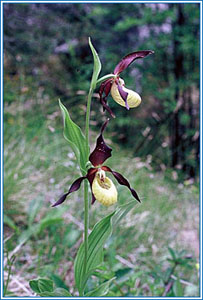
Cypripedium
calceolus L.
|
The
most famous European orchid, emblema of the French Orchid
Society (SFO), the Ladyslipper (Cypripedium
calceolus L.)
is also protected but may be not so endangered anymore. This
species grows mainly in the alpine region. |
Serapias
species are not so common in France and then following
species are getting some regional protection: Serapias
lingua which is present in the south part of France is
sometimes getting rare because of the drying of its habitats.
Serapias cordigera, is growing on the Mediterranean
region, quite frequent on the acid soils.
The following species are more common even if they got sometimes
a regional protection status. |
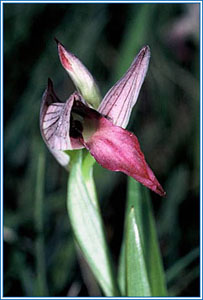 Serapias
lingua
Serapias
lingua |
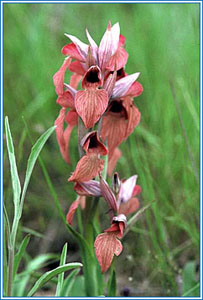 Serapias
cordigera
Serapias
cordigera |
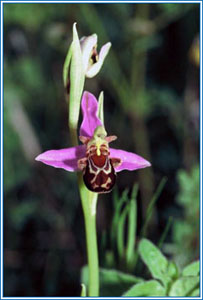
Ophrys
apifera L. |
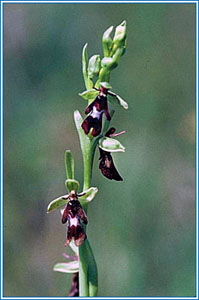
Ophrys
insectifera L |
Among
Ophrys species, bee orchid (ophrys apifera L.)
is one of the most frequent French orchids which grows on
the whole territory even colonizing the private lawns. Ophrys
insectifera L. is not so frequent maybe because of its
small size but present in nearly the whole territory.
|
ON: Is there a species which is already extinct
in the habitat?
JK: Apparently only one species disappeared
in the last 20 years: Anacamptis (=Orchis) collina
which was endemic from south France and remains now in foreign
countries.
ON: You also said that French Orchid mapping has been set up
since more than 20 years. Who are doing this map?
JK: Orchid mapping is a very important
task undertaken by SFO with financial help from the Ministry of
Ecology. Every department or district has a correspondent (cartographe
in French) who coordinates the prospections and computerizes the
data which are sent to the national level. National maps will
be built up by the National Natural History Museum.
ON: Which are the conclusions you have got with this mapping?
JK: Conclusions haven’t been validated
till now because all regions haven’t been completely updated.
ON: In what way you think the climatic changes and direct human
action caused variations on the population?
JK: Some species are in extension, while
others are more rare due probably to the earlier evocated threat
on humid zones. Some species area extension may be due to climatic
changes: this is the case for instance for species Himantoglossum
(=Barlia) robertianum which existed before only
in the Mediterranean districts and which is now reaching the Lyon
area.
ON: Those conclusions are already published and available for
people interesting in French orchids?
JK: Conclusions hav’nt been published
till now but I hope that they’ll be published soon.
At least, an Atlas of French orchids will be published within
the 2 next years with of course interpretation of mapping results.
ON: Thank you.
Litterature:
Bournerias et al Les orchidées de France, Belgique, Luxembourg
second edition December 2005.
Biotope editor
Photos: Koenig's
collection

Any
kind of reproduction (print, digital or anyone) of any
type of material of this site: texts, layout, photos,
images and others - is strictly forbidden without previous
written permission of the authors. Any solicitation or
information by the e-mail: bo@sergioaraujo.com |
|

